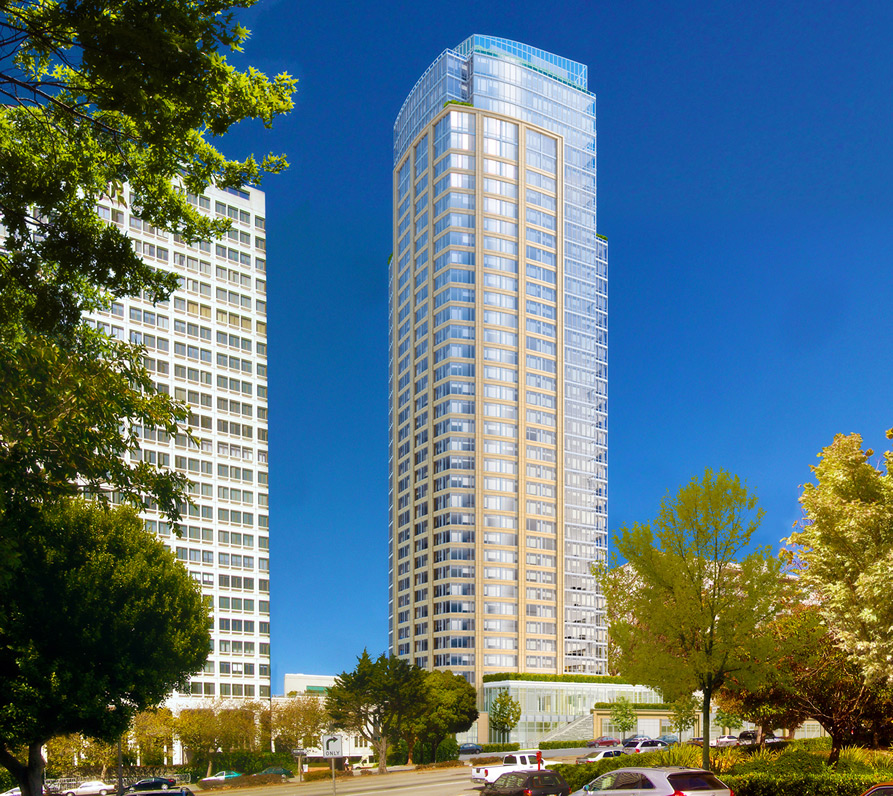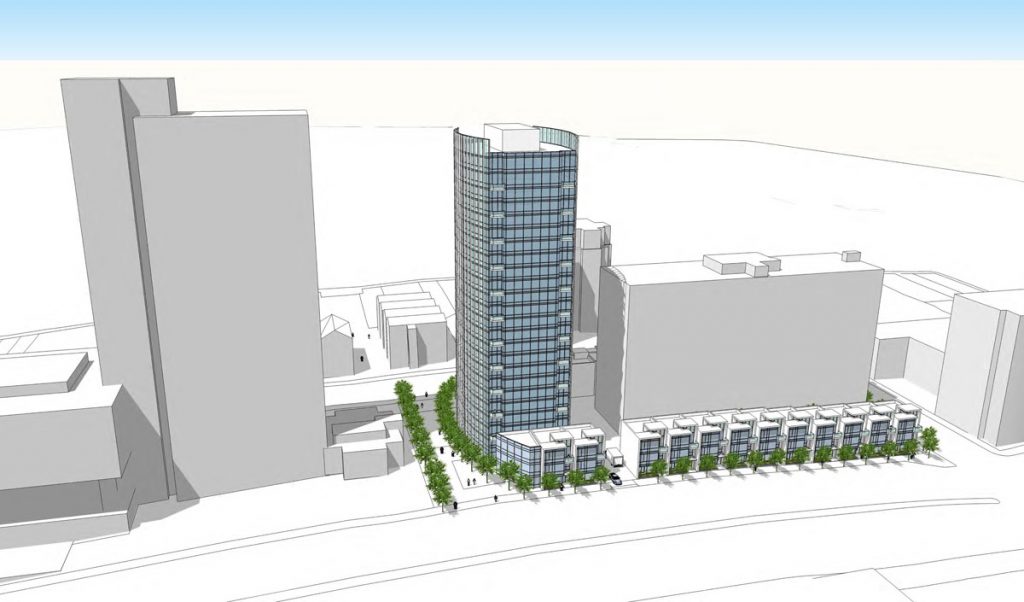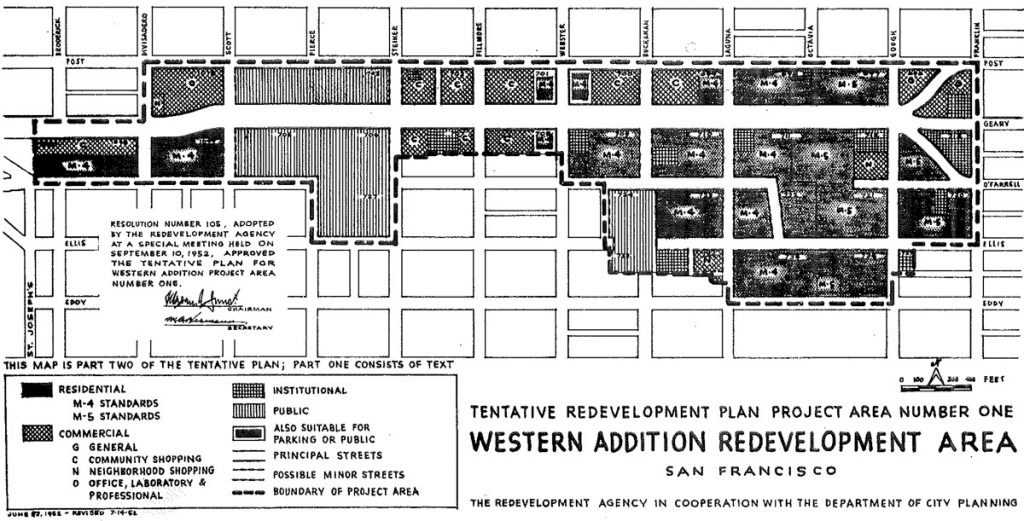By FRAN MORELAND JOHNS
It may be a sleek luxury high-rise condominium bringing new life to Cathedral Hill. Or it may be a code-violating, too-tall tower adding traffic, wind, noise, parking and shadow nightmares — and opening the door for more spot zoning across the city.
New York developer ADCO Group’s plan to build a 36-story residential tower at 1481 Post Street is drawing mounting concern and opposition from nearby residents. The project is expected to come before the Planning Commission in late September.
The building would replace an above-ground parking structure, fitness center and tennis courts that adjoin Cathedral Hill Plaza apartments at Post and Gough, which ADCO also owns and plans to remodel. The new tower would rise to 416 feet, requiring an exception to the 240-foot height limit the city planning code sets for the site.
ADCO — a key player in the redevelopment of Cathedral Hill five decades ago — is promising its project will be beneficial to the neighborhood.
“Benefits to the community will include significant streetscape improvements,” says ADCO’s Linda Corso. “What is now a blank wall on Geary will become a glass-front building with an expanded fitness center,” with a ground-level cafe and garden fronting 1481 Post and the apartments to the east. Adding pedestrian and residential activity and a mid-block crossing will enliven the area and increase safety, Corso maintains.
Corso says ADCO will also make extensive improvements to Cathedral Hill Plaza, the adjacent 14-story apartment building. Most significant would be a redesign of the entry from the current portico on Gough to an open entryway on Post.
But many neighbors aren’t buying it. An array of groups and individuals dubbed SOS Cathedral Hill, led by the Cathedral Hill Neighbors Association, opposes granting the exceptions required for both the height and bulk of the building.
In addition to concerns about traffic and shadowing, opponents say the size of the building would create safety issues for the hundreds of seniors who live in the immediate area.
“This proposed project would be out of scale and incompatible with the existing plan of our neighborhood,” says Marlayne Morgan, president of the Cathedral Hill association.
The neighborhood plan in question grew out of the much-reviled redevelopment push in the 1960s that leveled Japantown and gutted the heart of the Western Addition.
One early segment of the redevelopment area, centered around a new St. Mary’s Cathedral, became known as Cathedral Hill. Bordered roughly by Franklin, O’Farrell, Post and Octavia, Cathedral Hill was planned with residential buildings of varying heights up to 240 feet interspersed with open spaces — including the parking structure and tennis courts at 1481 Post. A restriction in the plan that prohibited building on the 1481 site expired after 40 years.
New York developer Alvin Dworman, founder and chairman of ADCO, played a key role in redeveloping Cathedral Hill. In addition to Cathedral Hill Plaza apartments, he built the 240-foot residential tower at 1200 Gough Street, on the corner of Geary Boulevard, and helped the Catholic Church put together land for St. Mary’s Cathedral. He also developed the Normandy apartments south of St. Mary’s.
ADCO’s promotional materials claim 1481 Post will be an especially important addition to the city’s housing stock because roughly half of its 262 units are “family-friendly,” with two bedrooms or more.
To get the variances it needs to exceed the height and open space requirements of the site, ADCO is touting the community benefits it is offering in exchange for code exceptions. “We are talking with organizations like the Buchanan YMCA, Boys and Girls Club, and groups in Japantown,” Corso says, and conducting “listening sessions” to assess neighborhood needs.
Opponents argue that community benefits are elusive and negligible, and do not offset the adverse impact of the luxury tower.
“Cathedral Hill is already a densely populated neighborhood, with more than 10,000 people per square mile, many of them elderly,” Morgan says. She points to the Martin Luther Tower on Franklin, the Sequoias and Nihonmachi senior housing projects, plus the Broadmoor, Coventry and Carlisle, which “have added hundreds of units for seniors to the many long-time residents who have aged in place.”
It is the threat to the senior population that also concerns Carlisle resident Gabriel Gregoratos, a retired cardiologist.
“The shadowing of senior housing for extended periods poses a health problem for the elderly,” Gregoratos says, “and the extra traffic will make Post a very difficult street to walk on.” Citing plans for several hundred additional cars entering and exiting on Post Street, Gregoratos says there will be very real danger to the thousands of seniors regularly walking, driving or taking public transportation in the area. “When we purchased these units, we were told of the potential building,” he says, “but we did not know ADCO would seek a variance to build a 36-floor tower.”
Gregoratos points out that the new California Pacific Medical Center will have entry and exit ramps for its emergency room two blocks away on Post Street.
ADCO’s Corso notes that the draft environmental impact report for the project — not yet approved — says the impact on parking and traffic would be negligible.
Cathedral Hill’s Morgan acknowledges changes in parking supply are not considered a significant environmental impact under current codes, but she says the impact will be real.
“The 442 parking spaces the developer proposes to build on this site will generate 3,182 net new trips per day,” Morgan says. “Even with one to one parking for 262 new spaces, there will still be a shortfall of 33 street parking spaces per day and 77 per evening.”
Neighbors have hired architects, lawyers and consultants to try to mitigate the effects of the new tower, and have submitted alternative designs to the Planning Commission. The consensus favorite proposed by Northern California Presbyterian Homes and Services, parent organization of the Sequoias, is within the 240-foot height limit.
“Our position has never been to oppose development of the site,” says Kathie Cheatham, former president of the Sequoias Residents Association and a board member of the parent organization. “That is their right. Our proposed design, with a 240-foot tower and townhouses on Post and Geary, would certainly increase the ‘eyes on the street’ and help preserve the neighborhood character. We have only asked for a sympathetic view toward the negative effects on the neighborhood that could be mitigated.”
Corso says her company has no interest in a smaller building.
“We could build a code-compliant building right now,” she says. “There would be no community benefits.”
Morgan notes that other developers have worked with community members to find acceptable compromises.
“ADCO should always have been providing benefits for the communities they displaced in the Fillmore and Japantown,” Morgan adds. “Fifty years later, we need major commitments from them for affordable housing, not more luxury condos. And spot zoning for this one project opens the door to height and density exemptions both here and in the surrounding neighborhoods west of Van Ness.”
There is a palpable sense of frustration on the part of SOS Cathedral Hill groups.
“The developer’s unyielding position in the face of community opposition is impossible to understand in the current San Francisco environment of working with the community to reach accord,” Cheatham says.
BACK IN THE SPOTLIGHT, 50 YEARS LATER
Behind the push-pull of residents and developer battling over the proposed luxury condo at 1481 Post are a million stories.
On one side are the stories of how those residents came to live there and scars that remain from the redevelopment of the neighborhood. On the other is the story of one highly regarded, immensely successful New York developer at the center of it all half a century ago — and now in the spotlight again.
Alvin Dworman, chairman, founder and singular force of ADCO Group, is the longtime central figure in the redevelopment of Cathedral Hill. Dworman was already well on his way toward the billions of dollars he would make for himself and his investors with varied developments across the U.S. when he first learned of San Francisco’s Western Addition Redevelopment A-1 project in 1960.
“I get this call saying you have to come to San Francisco right away, you can get the Western Addition,” he recalled in a rare 2007 interview with the San Francisco Business Times. “I said, ‘What the hell is that?’ I don’t think I had ever been in San Francisco before.”
But he made the trip, soon becoming what ADCO’s website describes as the Western Addition’s designated developer. Among the major parcels he acquired when the neighborhood was bulldozed was one key lot bordered by Post, Gough, Geary and Octavia. He put up a 14-story apartment building, Cathedral Hill Plaza, on the Gough Street end, with an adjoining above-ground parking structure topped by tennis courts on the western half.
The western portion was protected from development for 40 years, designated as one of the open spaces planned into the new Cathedral Hill area. Now, 40 years after buying the property, Dworman is back with a proposal to build a 36-story luxury tower with 262 units offering multiple amenities and views.
“Alvin doesn’t sell, he buys,” his friend former mayor Willie Brown told the Business Times.
During the 40 years Dworman sat on the property, the community grew, and aged. Senior homes and assisted living facilities, mostly church-related, went up around Cathedral Hill — most significantly the Sequoias, which is adjacent to 1481 Post, with 300-plus apartments and a 50-bed skilled nursing section. There is also a 12-story retirement condominium, the Carlisle, directly across Post Street, plus multiple other senior residences within a few blocks.
Nearby senior neighbors have become a vocal force in questioning why the city should allow Dworman to build a tower that so massively exceeds the area’s zoning.
Alvin Dworman claims his new project will create 262 “environmentally conscious, transit oriented homes and a more active and vibrant pedestrian experience.” If he succeeds, it will confirm the reputation that brought him to the area more than 50 years ago.
— Fran Moreland Johns
Filed under: Civics, Real Estate










